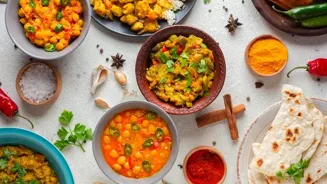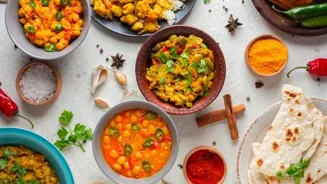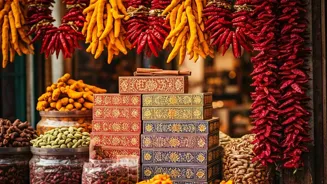Unraveling the Spice Trade: A Journey Through India's Culinary Heritage. Explore the history behind iconic flavors!
India, the land of vibrant culture and diverse traditions, is also globally renowned for
its gastronomic marvels. At the heart of Indian cuisine lies a rich tapestry of spices, each with its unique flavor and aroma, meticulously woven into culinary creations.
But have you ever wondered how these spices, which define Indian food, came to be so integral to our cooking? The answer lies in the fascinating journey of the spice trade, a historical phenomenon that irrevocably shaped the culinary landscape of India and the world.
India's rich spice history shaped global trade routes
For centuries, India has been a pivotal hub in the global spice trade. The country's favorable climate and diverse geography allowed the cultivation of a wide array of spices, from the peppery warmth of black pepper to the vibrant hue and earthy flavor of turmeric.
Ancient civilizations, like the Romans and Egyptians, recognized the value of these precious commodities, initiating maritime routes to acquire them. The allure of Indian spices extended far beyond their culinary applications.
They were prized for their medicinal properties, used in perfumes, and even as preservatives. This demand propelled India into a position of global prominence, attracting traders and explorers from across the globe.
Spice trade shaped Indian cuisine through cultural exchange
The spice trade was not merely a commercial exchange; it was a cultural exchange as well. As traders from different lands converged on Indian shores, they brought with them their own culinary traditions and ingredients.
These interactions led to a fascinating fusion of flavors and cooking techniques, gradually influencing the evolution of Indian cuisine.
For instance, the introduction of chili peppers by the Portuguese had a profound impact on Indian food, adding a fiery dimension that is now synonymous with many regional cuisines.
Similarly, the arrival of tomatoes and potatoes from the Americas further enriched the Indian culinary repertoire, finding their way into countless curries and vegetable preparations.
Spice trade shapes Indian cuisine with health benefits
The impact of the spice trade on Indian cuisine is undeniable. Spices are not just added to enhance the taste of food; they are considered essential ingredients that play a crucial role in balancing flavors and promoting health.
Each spice has its therapeutic properties, contributing to the holistic approach of Ayurveda, the ancient Indian system of medicine. From the anti-inflammatory properties of turmeric to the digestive benefits of ginger and cumin, spices are believed to have a positive impact on overall well-being.
This belief has further solidified their importance in Indian cooking, making them an integral part of our culinary heritage.
Spice trade shaped India's diverse regional cuisines with unique flavors
The spice trade transformed India into a melting pot of culinary influences. The integration of new ingredients and cooking methods from different cultures led to the development of distinct regional cuisines, each with its unique character and flavors.
From the Mughlai cuisine of North India, with its rich gravies and aromatic spices, to the South Indian cuisine, with its tangy tamarind and coconut-based curries, the spice trade has played a significant role in shaping the diverse culinary landscape of the country.
Each region boasts its own unique blend of spices, reflecting the local climate, agricultural practices, and cultural preferences.
The spice trade legacy shapes Indian cuisine today
The legacy of the spice trade continues to resonate in Indian cuisine today. Spices remain an indispensable part of our cooking, adding depth, complexity, and character to our dishes.
The aroma of spices wafting from Indian kitchens is a testament to the enduring influence of this historical phenomenon. As we savor the flavors of our diverse culinary heritage, let us remember the journey of the spice trade, which has shaped not only our food but also our identity as a nation.
The vibrant spices of India are a reminder of the rich cultural exchange that has shaped our land.
Spices: A Cultural Legacy in Indian Cooking
The influence of spices extended beyond the royal kitchens and grand feasts; they permeated into the daily cooking of common households. Recipes were passed down through generations, each family preserving and adapting the traditional spice blends to their own tastes.
This ensured the preservation of culinary heritage and the continued prominence of spices in everyday meals. The intricate knowledge of spices, their combinations, and their uses became an integral part of Indian culinary wisdom.
Spice trade diversifies Indian agriculture, boosts economy
The spice trade brought diversity to Indian agriculture, encouraging farmers to cultivate a wider variety of spices. This, in turn, led to the development of new agricultural techniques and irrigation methods, further boosting the agricultural economy.
The success of the spice trade also spurred the growth of ancillary industries, such as spice processing, packaging, and transportation, creating employment opportunities and contributing to overall economic prosperity.
Indian spice trade shaped cosmopolitan hubs, fostering cultural exchange
The demand for Indian spices created bustling trading centers and port cities along the Indian coast. These cities evolved into cosmopolitan hubs, attracting merchants, artisans, and laborers from different parts of the world.
This led to a cultural exchange that went beyond culinary influences, impacting art, architecture, and language. The spice trade played a significant role in shaping the urban landscape of India and fostering a spirit of openness and interaction with the outside world.
India's spice legacy shapes global culinary traditions
Today, India continues to be a major producer and exporter of spices, catering to the global demand for authentic flavors. Indian spices are not only found in home kitchens but also in restaurants, food processing industries, and pharmaceutical companies around the world.
The legacy of the spice trade extends far beyond the borders of India, influencing culinary traditions and economies on a global scale. The story of Indian spices is a testament to the enduring power of culture and commerce.
European spice trade impacts Indian society and cuisine
The spice trade was not without its challenges. Competition among European powers for control of the spice routes led to conflicts and colonization. The impact of colonialism on Indian society was profound, with long-lasting consequences for its economy, politics, and culture.
However, despite the challenges, the spice trade left behind a lasting legacy of culinary innovation and cultural exchange, shaping the unique flavor of Indian cuisine.
Indian spices: rich history and trade shaping culinary identity
As we enjoy a flavorful Indian meal, let us remember the journey of the spice trade, which has woven together the diverse flavors and ingredients that define our culinary identity. The spices of India are a reminder of the rich cultural heritage and the enduring power of trade.
They speak of a vibrant history, a diverse landscape, and a culinary tradition that continues to evolve and delight the world.
AI Generated Content. Glance/InMobi shall have no liability for the content









